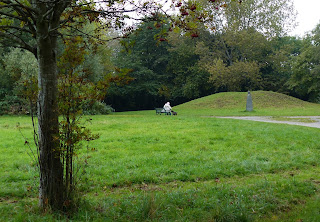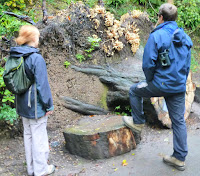Twenty years or so ago it was a completely different story as many of you will remember. There was poor maintenance, vandalism by car and motorbike thieves and the burnt out wreckages of their activities were abundant.
The general improvement in the wood has been largely due to the activities of people such as you, within the framework of the Friends of Badock's Wood (FOBW) working with the council. I'll paste below a piece from the FOBW website about the formation of the group.
In June 2000 a local resident, the late Salim Allibhai, organised a meeting, called in a multitude of local agencies, including the City Council, the Police and the relatively recently formed Friends of Badock's Wood. This meeting started a process of renewal, both of the Woods themselves and of the Friends and by the time of Salim's death, in 2004, the situation in the woods had completely changed. Since that time, the Friends have been closely involved in working with the City Council in producing and implementing management plans for the area, undertaking volunteer work, acquiring grant aid and holding events....
If you would like to read more click here.
Not only do the FOBW try to make the wood a better place for us but also for the wildlife. I took the photos of these birds, grey wagtail and great tit in September and these birds are dependant on healthy and vigorous vegetation so that fruit and nuts as well as other seeds can flourish as a food source. The grey wagtail is looking for water creatures which in turn depend on clean water.
The great tit was making a loud tapping noise as it broke pieces off the nut and the sound could easily be mistaken for that of a woodpecker.
Talking of misleading sound, it is worth mentioning the strange noises that squirrels sometimes make. It can be a churring noise of varying pitches and I find myself wondering what strange bird can be making the noise, only to discover that it's a squirrel warning of my presence or perhaps sending some other message to its neighbours. If you hear an odd noise when you're in the wood just stop and look around. There might very well be a squirrel close by.
 Unfortunately the vandalism and thoughtlessness hasn't stopped altogether. Trees are sometimes badly damaged. These photos are evidence of recent damage and it is very difficult to stop.
Unfortunately the vandalism and thoughtlessness hasn't stopped altogether. Trees are sometimes badly damaged. These photos are evidence of recent damage and it is very difficult to stop.Two separate trees are involved, the two bottom photos being of the same tree. There might be other incidences throughout the wood but these are two that I've noticed recently.
As well as vandalism of course there is also litter left around. Fortunately this is easier to deal with than the vandalism. Most of the litter is in the form of drinks cans and bottles but there is a lot of paper and plastic left lying around.
There are two full bags of rubbish which look as though they have been thrown over a fence into the wood from the Clover Ground area. In the same area there is an old television or computer screen, a baby seat as well as other unwanted bits and pieces. Of course they could have been brought from anywhere. Fortunately they are fairly well hidden by trees but they will be removed by the council when they are informed.
Another form of thoughtlessness concerns dog mess but fortunately most dog owners are very responsible and we are all grateful to those of you who are diligent in picking up. I know that sometimes the dog litter bins are overfull but I'm sure the council do their best with limited resources.
I've put in this photo of a squirrel as a reminder of warmer days. In fact it was taken in July and the squirrel was snoozing very high up in a tree by the sports field and perhaps sleeping off a morning's feasting on berries and succulent shoots. It might also be tired from a morning's work of hiding food away for the winter but perhaps that comes later when nuts and acorns are abundant. Fortunately it didn't turn over in its sleep. At least, not while I was watching.
Yes, you guessed, I am leading up to something.
If you feel you would like to help with the maintenance of Badock's Wood, and I know many of you do already, please let the group know. FOBW now has dedicated email addresses so that those individuals who organise the various groups within FOBW can reply to you directly.
At present there are three main groups:-
Litter collection. The FOBW hopes to have a litter collection approximately monthly through the year but being on the list does not mean you will be asked to collect monthly. If there are enough volunteers we will organise a rota, but you can volunteer to do as much or as little as you wish. FOBW will lead and provide information and any necessary equipment.
Work Parties. FOBW also plan to organise regular conservation work parties to manage the woodland and meadow for wildlife. This will include trimming scrub, pruning invasive saplings and plants and hay raking. Of course these activities are dictated by season and weather. Instruction and tools will be provided where necessary.
Bird Group. There are some people within FOBW who are particularly interested in birds. Some members carry out an early morning bird survey approximately fortnightly. Naturally this can't be an accurate record of bird numbers but it keeps us in touch with what is happening with birds in the wood. We don't have formal meetings but we do share with each other if we see something unusual or of interest. All levels of experience welcome.
FOBW would be grateful for your interest and your assistance.
In the first instance please contact: fobwsecretary@yahoo.co.uk .
- If you are already on the mailing list then write to say which group or groups you are interested in joining.
- If you are not already on the mailing but would like to be involved then send an email to the above address and ask to be put on the mailing list and mention which group or groups you would like to be part of.
- If you would like to be on the mailing list but don't feel ready or able to be in a group then send an email and ask to be put on the mailing list.
Friends of Badock's Wood website: www.fobw.org.uk
The woods are lovely at this time of year so it's a good time to dress up warm to go out and enjoy it !!
If you would like to comment, please email me at:- badockswood@virginmedia.com
If you would like notification on new posts then please put your email address in the box on the right at the top of the page.
mike townsend












































 I don't know the names of them but I do find them fascinating and these photos have been taken recently as I walked around the wood. They have their individual preferences for live trees, leaf mould or decaying wood. Often they are not immediately noticeable so peer into the undergrowth or around a dead tree trunk and see what you can find. I have no idea which ones are edible and which ones are not and so I would not even think about eating any of them.
I don't know the names of them but I do find them fascinating and these photos have been taken recently as I walked around the wood. They have their individual preferences for live trees, leaf mould or decaying wood. Often they are not immediately noticeable so peer into the undergrowth or around a dead tree trunk and see what you can find. I have no idea which ones are edible and which ones are not and so I would not even think about eating any of them.



